The Australian dollar (sign: $; code: AUD) is the currency of the Commonwealth of Australia (including its territories), Kiribati, Nauru, and Tuvalu. It is subdivided into 100 cents (symbol: ¢). Within Australia, it is most commonly abbreviated with the dollar sign, though A$ is also used to distinguish it from other dollar-denominated currencies. It was first issued on February 14, 1966.
Introduction[]
- Main article: Australia
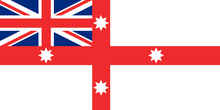
Australia's flag during its colonial period.
The first people to settle on Australia are believed to have arrived between 40,000 and 70,000 years ago. The first authenticated European landing on Australia was in 1606, by Dutch navigator Willem Janszoon and his crew, though there are arguments as to whether this is accurate. In 1788, British settlers founded Port Jackson and the land of modern-day Australia was divided into several penal colonies. These colonies were united in 1901, into the Commonwealth of Australia, and the country received full sovereignty in 1931.
During the 18th century, Australia imported British, Dutch, Indian, Portuguese, and Spanish coins to be used as currency. The territory's first coinage was introduced in 1813, including a 15 pence and 5 shilling coin (known as the "Holey dollar"). The pound sterling was later introduced, followed by the Australian pound in 1909.
History[]
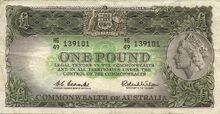
The pound was replaced by the dollar.
On February 14, 1966, the dollar was adopted, replacing the Australian pound. Beforehand, there were several suggestions as to what the expected currency would be called. In 1965, Prime Minister Robert Menzies, a monarchist, wished to name the currency the royal. Other proposed names included the austral, the oz, the boomer, the roo, the kanga, the emu, the digger, the kwid, the dinkum, and the ming. As a result of Menzies' influence, the name royal was chosen, and trial designs were prepared and printed by the Reserve Bank of Australia. However, the choice for the name was unpopular, and was later dropped in favor of the dollar.
Coins[]
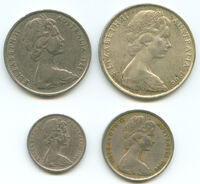
Early coins of the dollar.
In 1966, coins were introduced in denominations of 1, 2, 5, 10, 20, and 50 cents. The original 50 cent coins had a high silver content and were withdrawn after a year, for fear that the value of the silver content would exceed the face value of the coins. In 1984, 1 dollar coins were introduced, followed by 2 dollar coins in 1988. The 1 and 2 cent coins were discontinued in 1991 and withdrawn. In 2000, some were melted down and turned into bronze medals for the 2000 Summer Olympics in Sydney. Cash transactions are rounded to the nearest five cents. As with most public changes to currency systems, there has been a significant amount of seignorage of the discontinued coins.
All Australian dollar coins produced thus far bear a portrait of Queen Elizabeth II on the obverse, as she has been the reigning Sovereign since the dollar was established. However, the portrait has changed several times to match changing official portraits of the Queen as she ages. The first change was made the year the dollar was introduced, in 1966. The next came in 1985, with a new crown and pose, and finally, the most recent, in 1999, showing a more age-appropriate portrait of Elizabeth. In 2000, the Royal Australian Mint circulated a commemorative 50 cent coin marking the Royal Visit of Queen Elizabeth II, bearing a different portrait than those on other Australian coins in circulation at the time. It was the first instance that an Australian coin bore a representation of the Sovereign which was not synchronous with that used in the other Commonwealth Realms. In 2001, the typical portrait was restored.
Current Australian 5, 10, and 20 cent coins are identical in size to the former Australian, New Zealand, and British sixpence, shilling and two shilling (florin) coins. In 1990, the UK replaced these coins with smaller versions, and New Zealand followed in 2006. In circulation, New Zealand 5, 10, and 20 cent coins were often mistaken for Australian coins of the same value, as a result of their identical size and shape.
Commemorative coins[]
- Main article: Commemorative coins of Australia
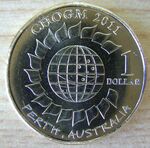
A commemorative 1 dollar coin of 2011.
The first Australian dollar commemorative coin was minted in 1970, with a denomination of 50 cents, commemorating James Cook's exploration along the east coast of the Australian continent. This was followed in 1977 by a coin for Queen Elizabeth II's Silver Jubilee. In 1986, the first commemorative 1 dollar coin was issued, marking the International Year of Peace. In 1995, the first commemorative 20 cent coins were introduced. Today, the 20 cent, 50 cent, and 1 dollar denominations are the most commonly used for commemorative coinage. However, commemoratives with denominations of 1, 2, 5, 10, and 55 cents, 2, 5, 8, 10, 15, 25, 30, 50, 100, 200, 300, 1000, 3000, and 1,000,000 dollars have been issued. All Australian commemorative coins are legal tender within the country, but are hardly ever found in circulation.
Banknotes[]
First series[]

An Australian dollar note from 1968.
The first series of Australian dollar notes was issued in 1966, with denominations of 1, 2, 10, and 20 dollars. In 1967, the 5 dollar note was introduced, after the public had become familiar with decimal currency.
In 1973, the 50 dollar banknote was introduced, followed by the 100 dollar note. In 1984, the 1 dollar note was replaced by a coin, and the same happened to the 2 dollar note in 1988. All notes of the first series were printed on paper.
Second series[]
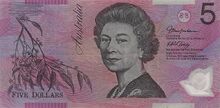
A polymer 5 dollar note.
In 1988, after a significant amount of research and development by the Commonwealth Scientific and Industrial Research Organization (CSIRO), the Reserve Bank of Australia issued their second banknote series, which contained notes composed of polypropylene polymer. They were printed to commemorate the 200th anniversary of European settlement in Australia. In 1996, Australia became the first country to have a full set of circulating polymer banknotes in all denominations.
These banknotes are sized according to denomination, for the visually impaired. They are all the same height, but different widths in order of their value; the 5 dollar note is the smallest, and the 100 dollar note is the largest. In addition, the notes are also color-coded: $5 pink; $10 blue; $20 red; $50 yellow; and $100 green.
For security, these notes bear a transparent window with an image of Captain James Cook. Also, every note has a seven-pointed star which has only half the printing on each side as well as a watermark of the Australian coat of arms.
Value[]

|
This page uses Creative Commons Licensed content from Wikipedia (view authors). |

The Australian dollar was initially pegged to the U.S. dollar.
When the Australian dollar was introduced in 1966, its international currency relationships were maintained under the Bretton Woods system, a fixed exchange rate system using a U.S. dollar standard. The Australian dollar, was effectively pegged to the pound sterling at an equivalent value of about 1 gram of gold.
The highest valuation of the Australian dollar to the United States dollar was during its period of being pegged to the U.S. dollar. On September 9, 1973, the peg was adjusted to US$1.4875, the fluctuation limits being changed to US$1.485 - US$1.490. On December 7 and December 10, 1973, the noon buying rate in New York City for cable transfers payable in foreign currencies reached its highest point of 1.4885 U.S. dollars to one Australian dollar.
On October 25, 2010, the Australian dollar's value became equal to that of the United States dollar for the first time since becoming a freely traded currency, trading above US$1 for a few seconds. The latter then traded above parity for a period of several days in November, and fluctuated around that mark into 2011. On July 27, 2011, the Australian dollar traded at $1.1080 against the United States dollar, a record since 1983. Some suggest that in 2014, the dollar could rise to as high as 1.70 USD.
Though the dollar is not considered a reserve currency, its volatility and unusual movement in exchange rates has contributed to its status as one of the most traded currencies in the world. Other factors include a relative lack of central bank intervention, and general stability of the Australian economy and government. In January 2011, it was announced by the World Economic Forum that the Central Bank of Russia would begin using AUD currency reserves.
Exchange rates[]
Before 1983, Australia maintained a fixed exchange rate. From 1946 to 1971, Australia maintained a peg under the Bretton Woods system, a fixed exchange rate system that pegged the United States dollar to gold, but the Australian dollar was effectively pegged to the pound sterling until 1967.
Following the breakdown of the Bretton Woods system in 1971, Australia converted its traditional peg to a fluctuating rate against the United States dollar. During September 1974, Australia valued its currency against a number of currencies in an effort to reduce the fluctuations associated with its tie to the U.S. dollar.
On December 12, 1983, Prime Minister Bob Hawke and Treasurer Paul Keating floated the dollar, with the exchange rate reflecting the balance of payment.
| Current AUD exchange rates | |
|---|---|
| From Google Finance [1]: | CAD CHF EUR GBP HKD JPY USD |
| From Yahoo! Finance [2]: | CAD CHF EUR GBP HKD JPY USD |
| From OzForex [3]: | CAD CHF EUR GBP HKD JPY USD |
| From XE.com [4]: | CAD CHF EUR GBP HKD JPY USD |
| From OANDA.com [5]: | CAD CHF EUR GBP HKD JPY USD |
References[]
Australian dollar on the English Wikipedia
Australian commemorative coins on the English Wikipedia
History of Australia on the English Wikipedia
- NumisMaster
Template:Australian dollar
